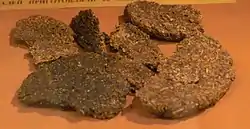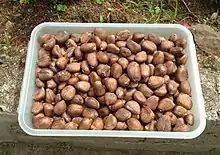Famine food
A famine food or poverty food is any inexpensive or readily available food used to nourish people in times of hunger and starvation, whether caused by extreme poverty, such as during economic depression or war, or by natural disasters such as drought.

Foods associated with famine need not be nutritionally deficient, or unsavory. People who eat famine food in large quantity over a long period of time may become averse to it over time. In times of relative affluence, these foods may become the targets of social stigma and rejection.
The characterization of some foodstuffs as "famine" or "poverty" food can be social. For example, lobster and other crustaceans have been considered poverty food in some societies and luxury food in others depending on the time period and situation.
Examples

A number of foodstuffs have been strongly associated with famine, war, or times of hardship throughout history:
- The breadnut or Maya nut was cultivated by the ancient Mayans but is largely rejected as a poverty food in modern Central America.
- In Polynesia, plants from the genus Xanthosoma, known locally as ʻape, were considered famine food and used only when the taro crop failed.[1]
- Several species of edible algae, including dulse, channeled wrack and Irish moss (Chondrus crispus), were eaten by coastal peasants during the Great Famine in Ireland of 1846–1848. Further inland, famine foods included stinging nettle, wild mustard, sorrel and watercress.[2][3][4][5] In the area of Skibbereen, people resorted to eating donkey meat, earning the nickname "Donkey Aters" (Eaters) for people in the area.[6] Others ate dogs, cats, corncrakes, rotten pigs and even human flesh.[7][8] The consumption of silverweed, sea anemones, wild carrot, sloes, pignut, common limpet, snails, dock leaves, sycamore seeds, laurel berries, holly berries, dandelion, juices of red clover and heather blossoms are also recorded.[9][10][11][12] Many accounts of the Famine mention people dying with green stains around their mouths from eating grass or other green plants.[13][14]
- Sego lily bulbs were eaten by the Mormon pioneers when their food crops failed.
- Tulip bulbs and beetroots were eaten in the German-occupied parts of the Netherlands during the "hunger winter" of 1944–45.
- During a number of famines in Russia and the Soviet Union, nettle, orache, and other types of wild plants were used to make breads or soups.[15]
- In Iceland, rural parts of Sweden, and Western Finland, mushrooms were not widely eaten before World War II. They were viewed as food for cows and were also associated with the stigma of being a wartime and poverty food.
- In times of famine in Scandinavia, the cambium (phloem) of deciduous trees was dried, ground, and added to extend what grain flour was available, to create bark bread. This is thought to be a Sami tradition.
- The word Adirondack, describing the indigenous peoples that lived in the Adirondack Mountains in New York, is thought to come from the Mohawk word 'ha-de-ron-dah' meaning 'eaters of trees'. This name was said to be used by the Iroquoians as a derogatory term for groups of Algonquians who did not practice agriculture and therefore sometimes had to eat tree bark to survive harsh winters.
- Cat meat was eaten in the northern Italian regions of Piedmont, Emilia-Romagna, and Liguria in times of famine, such as during World War II.[16]
- Likewise, during the Siege of Paris in the Franco-Prussian War, the menu in Parisian cafes was not limited to cats but also dogs, rats, horses, donkeys, camels, and even elephants.
- During the Japanese occupation of Malaya, due to a severe shortage of rice, the locals resorted to surviving on hardy tuberous roots such as cassava, sweet potato, and yam.
- During the Battle of Bataan in the Philippines during World War II, Filipino and American servicemen resorted to consuming dog meat, monkey meat, and the meat of monitor lizards (referred to as "iguana lizards" in the source), pythons, mules, horses, parrots, owls, crocodiles and carabaos as their supply of food dwindled.[17]
- In the semi-arid areas of the Brazilian Northeast, the shoots and leaves of cactus Opuntia cochenillifera are normally used to feed the livestock (cattle and goats). But during long droughts, people may use them as a last resort.[18]
- Historically in the Maldives the leaves of seaside trees such as the octopus bush and the beach cabbage were often used as famine food.[19]
- The caper, the flower bud and berry of Capparis spinosa species, has been a famine food in southern Ethiopia and Sudan as well as in the 1948 siege of west Jerusalem.[20][21]
- During the Cambodian humanitarian crisis, people ate tarantulas, scorpions, silkworms, and grasshoppers. Fried tarantulas later became a delicacy popular with tourists in the Cambodian town of Skuon.[22]
- Morinda citrifolia is sometimes called a "starvation fruit", implying it was used by indigenous peoples in the South Pacific as emergency food during times of famine.
- In Haiti, mud cookies are sometimes eaten by the poorest people to avoid starvation. Similar mud cookies are eaten in Zambia, Guinea and Cameroon for their nutritional content.
See also
- Government cheese
- Jiuhuang Bencao, 1406 Chinese illustrated herbal for famine foods
- Peasant foods
- Staple food
- Taboo food and drink
- Turnip Winter
References
- Abbott, Isabella Aiona (1992). Lā'au Hawai'i: traditional Hawaiian uses of plants. Honolulu, HI: Bishop Museum Press. p. 5. ISBN 0-930897-62-5. OCLC 26509190.
- "Food for the starving". www.ballinagree.freeservers.com.
- McBride, Doreen (8 February 2018). The Little Book of Fermanagh. History Press. ISBN 9780750985406 – via Google Books.
- Gribben, Arthur (1 March 1999). The Great Famine and the Irish Diaspora in America. University of Massachusetts Press. p. 31 – via Internet Archive.
charlock famine.
- "Holdings: Nettles and charlock as famine food". sources.nli.ie. 1959.
- Connaughton, Gary. "Here's The Explanation Behind The Weirdest Irish County Nicknames". Balls.ie.
- MacNamee, Donal (30 November 2020). "New RTE series finds four counties hit by cannibalism during Famine". Irish Mirror. Retrieved 25 January 2023.
- McGreevy, Ronan (30 November 2020). "Role of 'survivor cannibalism' during Great Famine detailed in new TV documentary". The Irish Times. Retrieved 25 January 2023.
- "Edible and Medicinal Herbs".
- Poirteir, Cathal (1 September 1995). Famine Echoes – Folk Memories of the Great Irish Famine: An Oral History of Ireland's Greatest Tragedy. Gill & Macmillan Ltd. ISBN 9780717165841 – via Google Books.
- Langan-Egan, Maureen (1999). "Some Aspects of the Great Famine in Galway". Journal of the Galway Archaeological and Historical Society. 51: 120–139. JSTOR 25535702 – via JSTOR.
- Enright, Damien (18 August 2008). "Enjoying a tasty treat from the salty sea". Irish Examiner.
- "Remembering the Past: An Droch Shaol- The Irish Holocaust | An Phoblacht". www.anphoblacht.com.
- "Eating people is wrong: Famine's darkest secret?" (PDF). www.econstor.eu. Archived (PDF) from the original on 11 December 2021.
- "Бурьян, крапива и лебеда. На одном из харьковских хлебозаводов выпекли "голодоморский" хлеб" Archived 23 July 2011 at the Wayback Machine, ATN Kharkiv.
- Clancy, Jim (24 February 2010). "TV chef dropped for cat recipe comments". CNN.
- Morton, Louis (1953). The Fall of the Philippines. United States Army Center of Military History. pp. 369–360.
- "Broto de Palma na culinária nordestina (Palma shoots in northeastern cuisine) GUEDES, Claudet Coelho. Federal University of Campina Grande. Access on January 15th, 2016". Archived from the original on 4 March 2016. Retrieved 15 January 2016.
- Romero-Frias, Xavier (15 April 2013). "Eating on the Islands – As times have changed, so has the Maldives' unique cuisine and culture". Himalmag. 26 (2) – via www.academia.edu.
- Yves Guinand and Dechassa Lemessa, "Wild-Food Plants in Southern Ethiopia: Reflections on the role of 'famine-foods' at a time of drought" Archived 11 October 2010 at the Wayback Machine UN-OCHA Report, March 2000 (accessed 15 January 2009)
- Ahmed, Badawi Ibrahim (1991). "Famine foods in eastern regions of the Sudan" (PDF). IAEA. MS thesis, Agriculture, Univ Khartoum. Retrieved 23 April 2017.
- "What it's like to eat a tarantula spider". CNN Travel. 1 February 2017. Retrieved 22 April 2018.
External links
 Media related to Famine food at Wikimedia Commons
Media related to Famine food at Wikimedia Commons